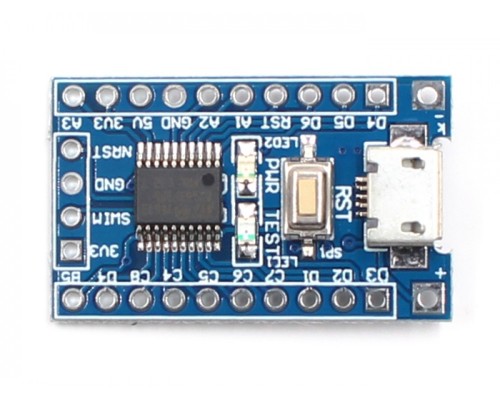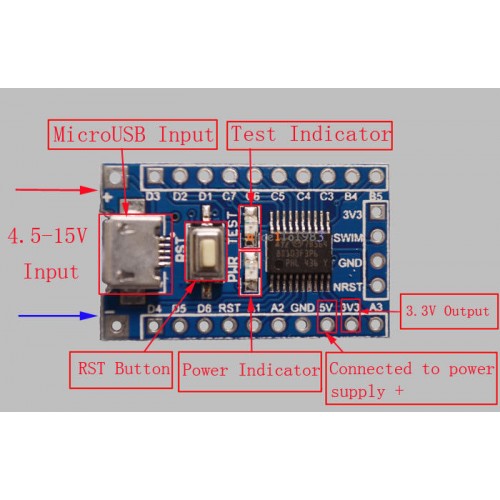https://tenbaht.github.io/sduino
https://github.com/tenbaht/sduino
The STM8S103 breakout boards are build around a CPU STM8S103F3P6 with 16MHz internal oscillator, 8kB flash, 1kB RAM, and 640 byte EEPROM.
The CPU includes a UART, SPI, I2C, PWM, 10 bit ADC, 3 timer, and up to 14 I/O pins - quite similar to an Atmel ATmega8.
One (red) LED is connected to GPIO PB5 (CPU pin 11). The push button is for reset. The CPU runs on 3.3V, a linear regulator is integrated on the board.
The micro USB connector is only for (5V) power supply, the data lines are not connected.
All CPU pins are easily accessible on (optional) pin headers (pitch 2.54mm, perfect for breadboards).

My breakout boards came preprogrammed with a blink program and with active write protection bits. For unlocking before first use:
stm8flash -cstlinkv2 -pstm8s103?3 -uConnection to the flash tool
I am using the ST-Link V2 compatible flash tool in the green plastic housing. The one in the metal housing uses a different pinout.
Connection to the flashtool:
| Signal name | P3 on CPU board | Green flash tool | Metal flash tool |
|---|---|---|---|
| 3V3 | 1 | 2 | 7 |
| SWIM | 2 | 5 | 5 |
| GND | 3 | 7 | 3 |
| NRST | 4 | 9 | 1 |
Pin number mappings
The Arduino environment uses its own pin numbering scheme independent from the physical CPU pin numbers. Many Arduino sketches and libraries contain hard-coded assumptions about the number of pins with special functions. Ideally, all these numbers would be the same and all programs could be compiled without changes.
Here I discuss some possible pin mapping schemes and check how close we could get the the ideal mapping. Unfortunatly, it turns out that a perfect mapping is not possible.
In the end I chose a simple geometric numbering for the square UFQFPN20 package starting with port pin PA1 and counting up from 0. This results in this mapping:

The pins D3/D4 (SDA/SCL, PB5/PB4) are different from the others as they are true open drain pins. That means, they only can drive the output low or open. To drive it high, they require the of an external pull-up resistor. This is the reason why the LED on this breakout is connected between +3.3V and the pins and not between the pin GND as usual. This way it is possible to drive the LED by writing a zero to the output register.
| sduino pin | STM8S103 CPU port pin |
|---|---|
| 0-2 | PA1-PA3 (PA1 and PA2 only weak output drivers) |
| 3-4 | PB5-PB4 (reverse order) |
| 5-9 | PC3-PC7 |
| 10-15 | PD1-PD6 |
برد sduino با قابلیت پشتیبانی از آردوینو
 68744
68744
- کد محصول: SDUINO-STM8S103F3P6
- موجودی: 2
-
161,000تومان
برچسب ها: برد sduino با قابلیت پشتیبانی از آردوینو


